LisbonLisboaPortugal.com
The best independent guide to Lisbon
LisbonLisboaPortugal.com
The best independent guide to Lisbon
The 10 best palaces of Lisbon and the surrounding region
The region surrounding Lisbon presents a landscape of royal ambition and architectural fantasy, holding one of Europe's most dense and varied collections of palaces. From the mist-covered peaks of Sintra to the grand, sun-washed avenues of the capital, Portuguese monarchs built residences that reflected their power and grandest visions.
These are not, however, simple monuments of a single era. This guide explores the sheer diversity of these properties. You will discover the flamboyant Romanticism of the Palácio da Pena, the monumental Baroque of the Palácio de Mafra, and the gilded Rococo "pleasure dome" of Queluz.
This guide details 10 of the most significant palaces in and around Lisbon. Each one revealing a different part of Portugal’s story, from its medieval origins to the opulent heights of its empire and its 19th-century Romantic revival.
The 10 best palaces of Lisbon
1. Palácio da Pena (Sintra)
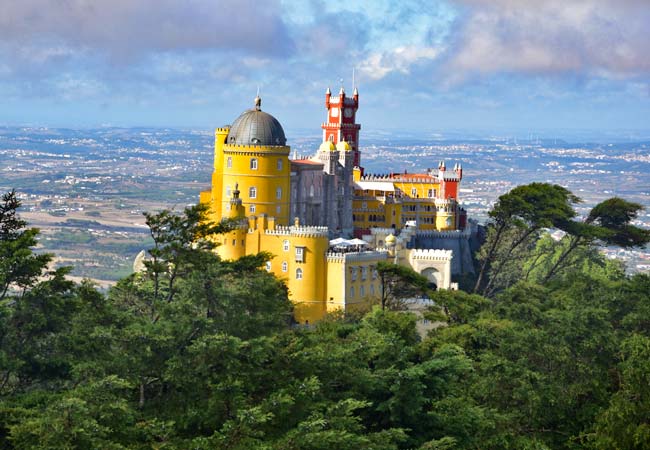
Crowning the highest peak of the Sintra hills, this palace is a dazzling expression of 19th-century Romanticism. Conceived as a grand artistic fantasy, its vibrant, multi-coloured facade is a whimsical blend of domes, battlements, and pastel hues. This magical castle is the definitive highlight of any visit to Sintra - Palácio da Pena guide
2. Palácio Nacional de Queluz (Queluz)
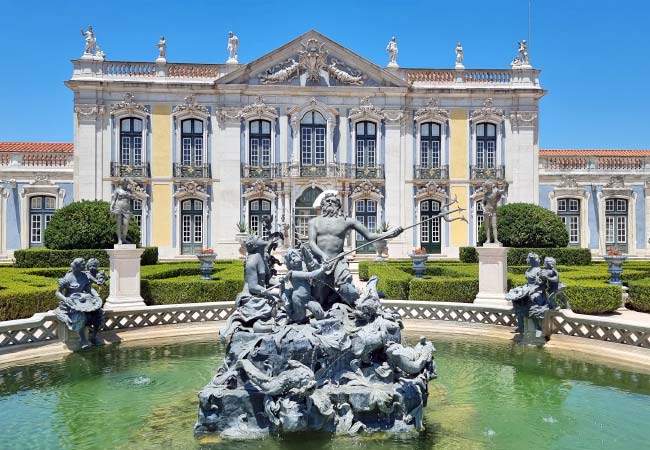
An exuberant 18th-century palace was a glittering stage for courtly pleasure. Conceived as a lavish summer retreat, it is a flawless time capsule of Rococo artistry. Its magnificent, mirrored halls and gilded Throne Room were designed for grand festivals and parties - Palácio de Queluz guide
3. Palácio Nacional da Ajuda (Lisbon)
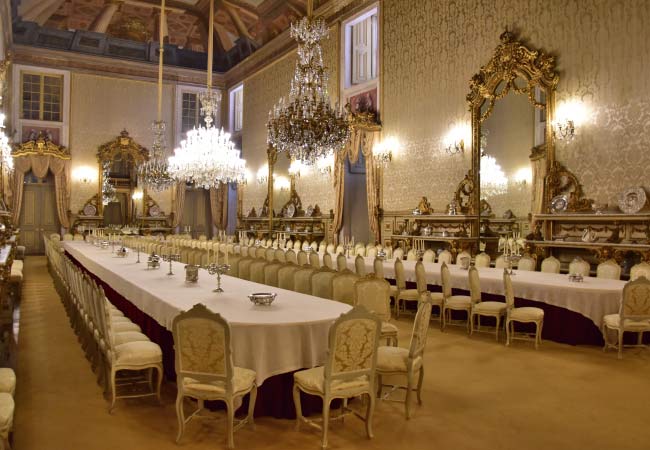
This grand Neoclassical palace was the last official residence of the Portuguese monarchy. Its opulent interiors, including a stunning throne room and grand banqueting hall, offer a formal glimpse into the final days of royal power and state functions - Palácio da Ajuda
4. Palácio Nacional de Sintra (Sintra)

Instantly recognisable by its two colossal conical chimneys rising over the town, this is Portugal’s best-preserved medieval royal palace. Located in the heart of Sintra's historic centre, it served as a favourite seat of power for the Portuguese monarchy for over eight centuries - Palácio Nacional de Sintra
5. Palácio de Mafra (Mafra)
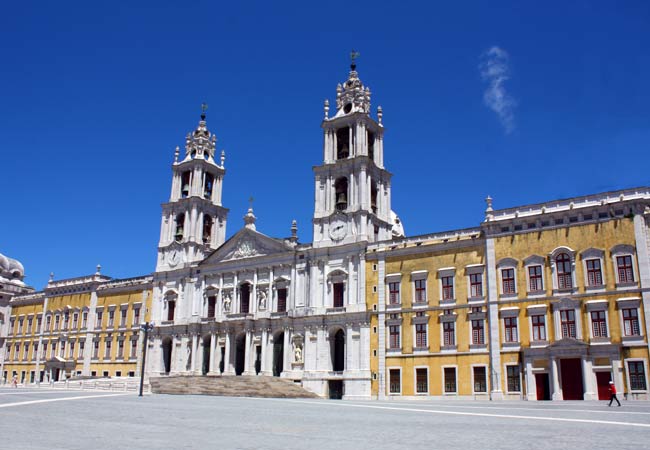
This colossal 18th-century monument is a staggering display of royal power, built from Brazilian gold. It combines a royal palace, a convent, and a basilica into one massive Baroque building. Its highlight is the magnificent Rococo library, considered one of the most beautiful in the world - Mafra guide
6. Palácio de Monserrate (Sintra)
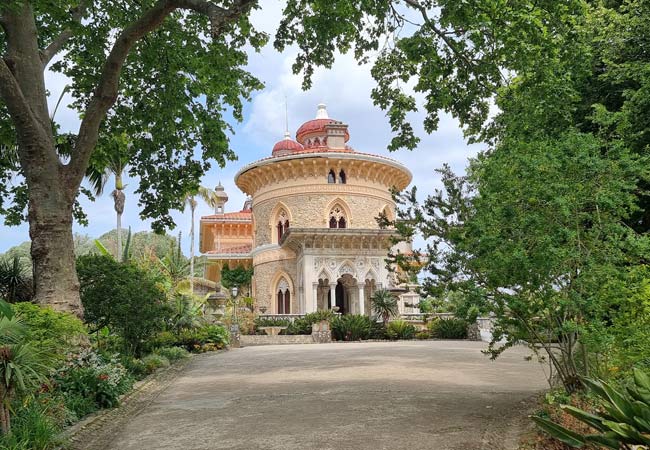
An exquisite jewel of Romantic design, this quiet palace is a fantasy of intricate, lace-like stonework. Its delicate architecture blends Gothic, Indian, and Moorish styles, creating a unique exotic retreat. It is set within magnificent botanical gardens that feature plants from across the globe - Palácio de Monserrate
7. Quinta da Regaleira (Sintra)
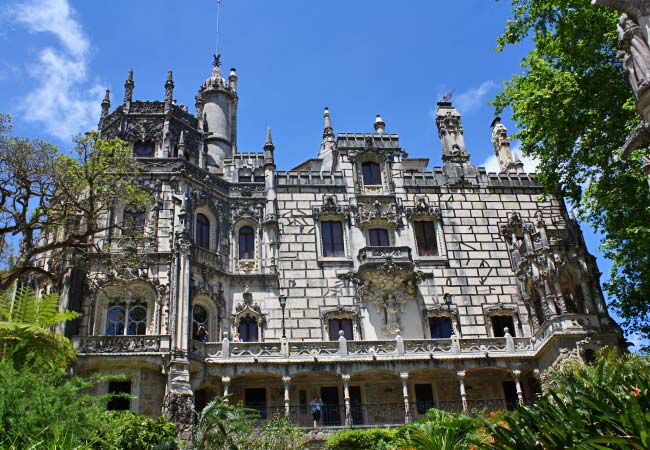
This is not a traditional palace but a mystical estate of hidden symbolism. Its flamboyant Neo-Manueline house is secondary to the gardens, which feature underground tunnels, grottoes, and the legendary Initiation Well, a 27-meter "inverted tower" designed for symbolic journeys - Quinta da Regaleira
8. Palácio dos Marqueses de Fronteira (Lisbon)
A true hidden gem, this 17th-century estate remains the private residence of the Marquesses of Fronteira. It is celebrated for its magnificent formal gardens and one of the world's most extensive collections of azulejo tiles, which depict battle scenes, allegories, and courtly life.
9. Palácio de Belém (Lisbon)
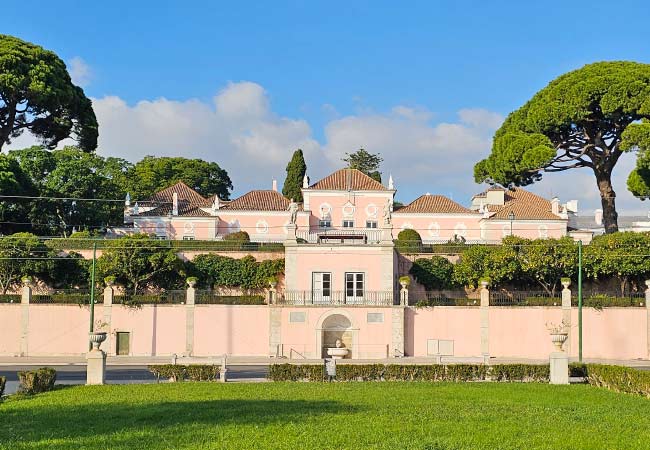
Facing the river, this elegant, pink-hued palace is the official residence of the President of Portugal. Once a royal summer retreat that survived the 1755 earthquake, it is now a symbol of the modern republic. The site also houses the Museum of the Presidency.
10. Palácio da Foz (Lisbon)
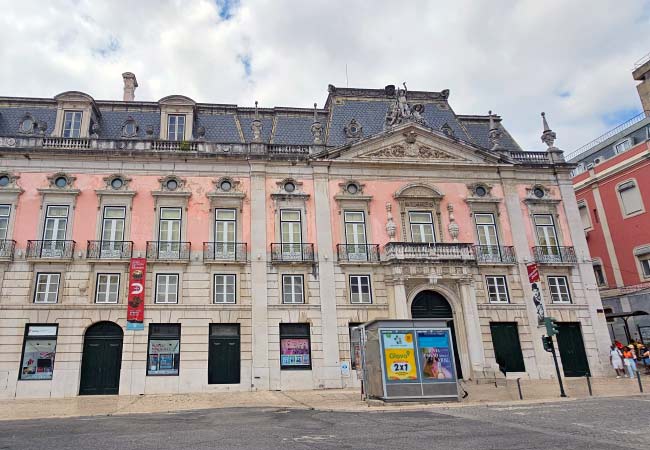
Located in the heart of Lisbon, this 18th-century palace was a lavish aristocratic residence. Its extravagant, French-inspired interiors are a celebration of the Gilded Age, culminating in a spectacular, ornate Hall of Mirrors. It now hosts cultural events and public offices.
The map below shows the location of these places throughout Lisbon and surround region.
Legend: 1) Palácio da Pena 2) Palácio Nacional de Queluz 3) Palácio Nacional da Ajuda 4) Palácio Nacional de Sintra 5) Palácio de Mafra 6) Palácio de Monserrate 7) Quinta da Regaleira 8) Palácio dos Marqueses de Fronteira 9) Palácio de Belém 10) Palácio da Foz
A Royal Timeline: How Portugal's Palaces Tell Its Story
The palaces of the Lisbon region are not just a random collection of buildings; they are a physical record of the Portuguese monarchy's journey. They tell a story of rising power, catastrophic disaster, and profound shifts in artistic taste. This timeline connects the most important royal palaces, from medieval fortresses to 19th-century fantasies.
1. The Medieval Foundations (12th-15th Centuries)
The story begins on Lisbon's highest hill at the Castelo de São Jorge. After the city's recapture from the Moors in 1147, this fortress became the first seat of the Portuguese kings. It was a residence of safety and defence.
At the same time, the monarchy favoured the cooler, forested hills of Sintra as a summer escape. Here, they built upon Moorish foundations to create the Palácio Nacional de Sintra. With its vast kitchens and iconic chimneys, this became the country's best-preserved medieval royal palace and a favourite residence for over 800 years.

2. The Golden Age and a New Vision (16th-17th Centuries)
During the Age of Discovery, Portugal became a global superpower. The medieval, fortified castle in Lisbon no longer suited this new-found confidence. King Manuel I built a magnificent new royal residence, the Ribeira Palace, directly on the waterfront (on the site of the modern Praça do Comércio). The court moved from the defensive hill to this opulent, riverfront palace, which became the new centre of power for 250 years.
3. The 18th-Century Boom: Power and Pleasure
The 18th century, funded by a massive influx of Brazilian gold, saw an explosion of royal construction. This wealth was expressed in two very different ways.
• A Monument to Power: King João V commissioned the Palácio de Mafra (started in 1711). This colossal Baroque complex, combining a palace, basilica, and monastery, was a staggering statement of absolute power and piety, intended to rival the great buildings of Rome.
• A Retreat for Pleasure: Meanwhile, the royal family sought a private escape. The Palácio Nacional de Queluz (started in 1747) was built as an intimate, Rococo "pleasure dome". It was a lavish summer retreat for music, parties, and leisure.
4. The Great Cataclysm (1755)
On November 1, 1755, a devastating earthquake, followed by a tsunami and fires, destroyed the heart of Lisbon. The royal Ribeira Palace was completely obliterated, and the king's vast library and art collection were lost forever.
The royal family, who were at the Palácio de Belém and survived, were traumatised. King José I developed severe claustrophobia and refused to live within stone walls ever again. He moved his entire court to a "Royal Tent," a huge complex of luxury tents and wooden pavilions on the hills of Ajuda.
With the main Lisbon palace gone, the court had no official residence. The summer retreat of Queluz was forced to become the new centre of state, and it was here that Queen Maria I would later be confined by her mental illness.
5. A New Palace, Interrupted (19th Century)
After the royal tent at Ajuda eventually burned down, construction on a grand, new stone palace began in 1802: the Palácio Nacional da Ajuda. This Neoclassical building was designed to be the monarchy's magnificent new permanent residence.
But in 1807, as Napoleon's armies invaded Portugal, the entire royal family fled to Brazil. Construction on Ajuda was halted for decades, leaving it an unfinished shell.
6. The Final Chapter: Two Opposing Visions
When the monarchy returned, the 19th century was defined by two opposing royal visions.
• The Formal State: The Palácio de Ajuda was finally (though never fully) completed and decorated. It became the official, formal residence in the 1860s. Its stiff, Neoclassical staterooms were used for grand banquets and state functions, representing the public face of the monarchy.
• The Romantic Fantasy: In complete contrast, King Ferdinand II, a German prince and known as the "Artist-King," was pursuing a personal dream. Steeped in German Romanticism, he acquired the ruins of a monastery high in the Sintra hills. Between 1842 and 1854, he transformed it into the Palácio da Pena, a fantastical, eclectic castle of vibrant colours. It was a personal, artistic statement, not a palace of state.
This final era perfectly captures the split: the formal, official monarchy resided at Ajuda, while its most imaginative spirit escaped to the fantasy world of Pena. When the monarchy fell in 1910, this long era of royal construction came to an end.
Lisbon’s finest palaces
Palácio da Pena
Crowning the highest peak of the Sintra hills, the Palácio da Pena is a dazzling and eclectic masterpiece of 19th-century Romanticism. It is the ultimate expression of this artistic movement, conceived as a grand fantasy by its creator, King Ferdinand II.
The palace is a vibrant, multi-coloured vision of domes, battlements, and pastel hues that seem imagined from a storybook. Its theatrical architecture is a deliberate and whimsical blend of many styles. Visitors will find Neo-Gothic towers, Moorish arches, and intricate Neo-Manueline details, a style that celebrates Portugal's 16th-century Age of Discovery.
The palace was built from the ruins of a 16th-century monastery, the original chapel of which is still preserved within the structure. Its interior is equally fantastical, with staterooms decorated in various styles, including a magnificent Arab Room and a grand Noble Hall.
The palace does not stand in isolation. It is the centrepiece of the vast Parque da Pena, a forested landscape of winding paths and exotic trees from around the world. The entire estate was designed as a complete work of art, a harmonious blend of nature and human imagination.
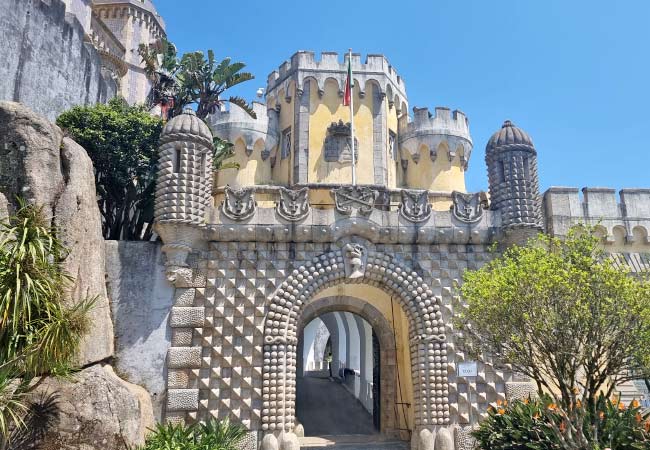
Palácio Nacional de Queluz
The Palácio Nacional de Queluz is one of Europe’s most exquisite examples of 18th-century Rococo architecture. Conceived as a sophisticated summer retreat, it was not a palace of state but an intimate world dedicated to leisure and entertainment. For much of its life, it served as a glittering stage for courtly pleasure, grand festivals, and garden parties.
Its opulent interiors are a flawless time capsule of this era. The magnificent Throne Room is the palace's gilded centrepiece, a spectacular hall designed by Jean-Baptiste Robillion for grand balls and state banquets. Its walls are a spectacle of carved gilded wood and enormous mirrors, all designed to sparkle under crystal chandeliers. The Ambassadors' Room, later used for formal audiences, was originally a grand concert hall.
The palace gardens extend this world of fantasy. The most unique feature is the Tiled Canal, a 115-meter-long waterway lined with magnificent azulejo panels depicting seascapes and courtly scenes. Here, the royal court would take gondola rides. The palace's story, however, is one of contrast; this world of pleasure also became a gilded prison for Queen Maria I as she descended into severe mental illness caused by extreme grief.
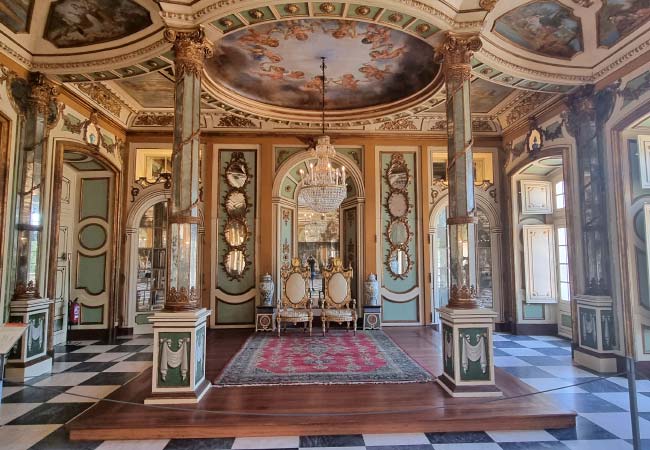
Palácio Nacional da Ajuda
The Palácio Nacional da Ajuda stands on a hill overlooking Lisbon, a grand monument to the final era of the Portuguese monarchy. This was not a summer retreat or a personal fantasy; it was a formal Neoclassical palace designed to be the official seat of power, the public face of the crown.
Its history is defined by broken ambition. Construction began in 1802, planned as a magnificent new permanent residence for the court, which had been homeless since the 1755 earthquake. However, when Napoleon’s armies invaded in 1807, the royal family fled to Brazil, and work on the grand project was halted for decades.
The palace was only (though never fully) completed in the 1860s, becoming the last official home of the monarchy. Its opulent interiors reflect this 19th-century state function. Visitors move through a series of grand, formal staterooms. The magnificent Throne Room is a spectacle of crimson velvet and gold, designed for state ceremony. The vast Banqueting Hall was set for enormous state dinners, while the private apartments offer a glimpse into the personal lives of King Luís I and Queen Maria Pia.
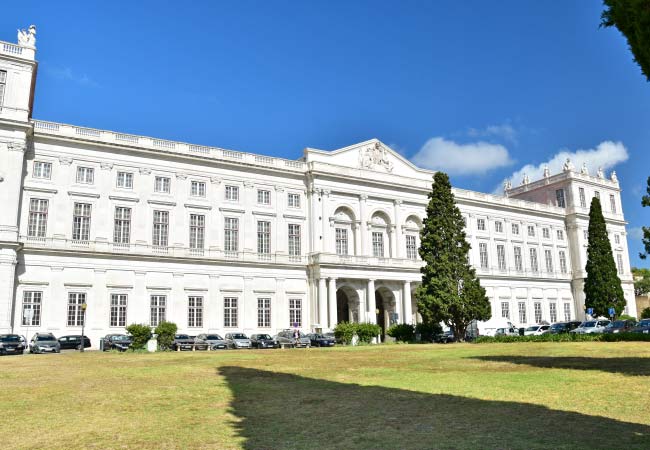
Palácio Nacional de Sintra
Dominating the historic centre of Sintra, the Palácio Nacional de Sintra is instantly recognisable by its two colossal conical chimneys rising over the town.
This is Portugal’s best-preserved medieval royal palace, having served as a favourite seat of power for the monarchy for over eight centuries. The immense span of time makes the palace a unique architectural record, a building not of one single vision, but of many
The interior is a journey through different eras, showcasing a stunning and harmonious blend of Gothic, Moorish (Mudejar), and Manueline styles. This is most evident in its significant collection of early azulejo tiles, which are some of the most important in the country. Its most famous staterooms tell the story of the court.
The magnificent Sala dos Brasões (Hall of Coats of Arms) features a spectacular domed ceiling painted with the arms of Portugal's 72 noble families. The Sala das Pegas (Magpie Room) is famed for its ceiling depicting magpies, a legendary response by the king to court gossip.
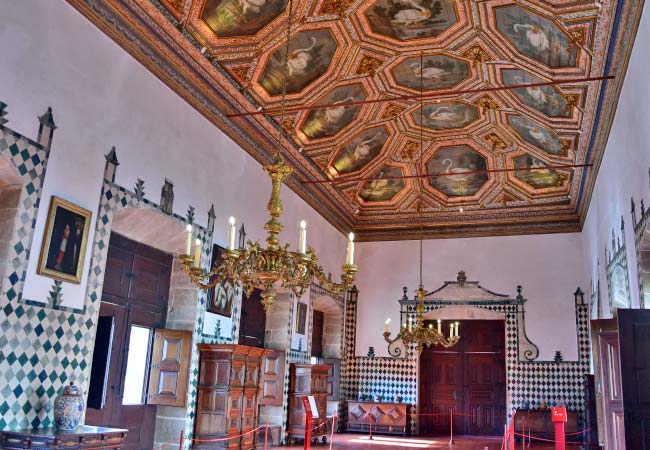
Discover more of Lisbon with our most popular guides
If you've found our content valuable, we'd welcome your support.
The digital publishing landscape has evolved significantly. As a small independent publisher, we face growing challenges. Search engines increasingly favour paid content over organic results, while AI-generated content often reproduces original work without attribution.
To support our work, please consider bookmarking this page (press Ctrl + D) for quick access. If you find an article helpful, we'd be grateful if you'd share it with friends on social media.
For specific questions, please see our Reddit community at r/LisbonPortugalTravel.
Should you notice any outdated or incorrect information, please contact us at [email protected]
Thank you for helping us continue to provide valuable content in an increasingly challenging digital environment.
A complete list of all of our Lisbon articles
If you've found our content valuable, we'd welcome your support.
The digital publishing landscape has evolved significantly. As a small independent publisher, we face growing challenges. Search engines increasingly favour paid content over organic results, while AI-generated content often reproduces original work without attribution.
To support our work, please consider bookmarking this page (press Ctrl + D) for quick access. If you find an article helpful, we'd be grateful if you'd share it with friends on social media.
For specific questions, please see our Reddit community at r/LisbonPortugalTravel.
Should you notice any outdated or incorrect information, please contact us at [email protected]
Thank you for helping us continue to provide valuable content in an increasingly challenging digital environment.


































